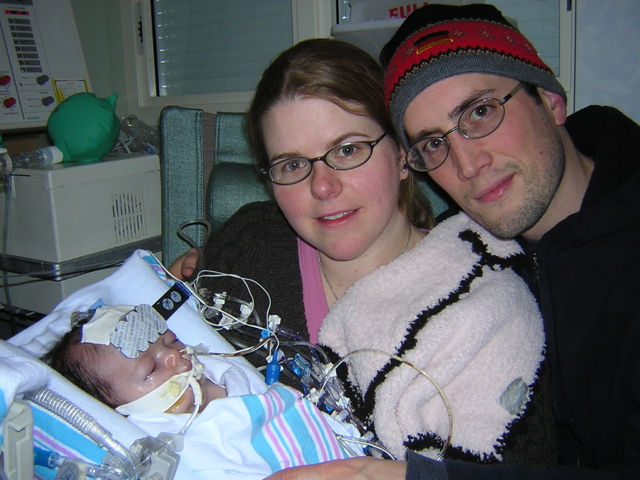Thu 28 Feb 2013
The following week at 6:45am my phone rang as Andy was showering for work. I was feeding and dressing our 2 and 9-month old-babies. There was 18 inches of snow on the ground from a storm the night before. Most of that phone call is a blur but the words I will never forget are, “This is the cardiologist…your daughter’s heart is quite abnormal…you need to take her to the emergency room right now.” I remember feeling inconvenienced and asked, “Right now? In a blizzard? During the workweek? Are you sure I have to go right now?”
Andy stayed behind with Simon and I went straight to the children’s hospital. When I checked in at triage, they quickly took her vitals and then ran her back to the biggest trauma room in the ER. Within ten minutes there were a dozen people in the room. Doctors, nurses and specialists were all shouting and scurrying around. Before Andy could even get there, Ramona was intubated, sedated and paralyzed. I heard someone say, “Her pulse-ox is reading 29!” “Is that good?” I asked hopefully. The doctor looked at me over the top of his glasses and shook his head with his lips pursed. He looked defeated. The parent liaison kept offering me something to drink.
Andy arrived and the cardiologist came out to talk with us in the consultation room, or as I call it, The Panic Room. It seems they never deliver good news in those tiny, windowless rooms. If it’s good news, they tell you in the waiting room or at the bedside. Ramona was going to require open-heart surgery and she wouldn’t be able to come home until she had it. He described her heart defect (called Tetrology of Fallot with pulmonary atresia and MAPCA’s) and what the surgery might involve.
We listened quietly, holding hands, stunned. The doctor continued to talk, pausing every once in a while and watching it dawn on us that our lives were now forever changed, that we were at a turning point, that we might not ever see our child open her eyes again. I could feel myself unraveling mentally but on the outside I was supremely composed, the First Lady of the Panic Room. Most people begin their grieving process in the denial phase, or in anger. I skipped straight to bargaining. I asked every question I could think of. “If the surgery goes well can we bring her home right away?” “If she recovers quickly can we expect her to have a normal life?” “Are we talking about the short bus?”
Ramona had been my closest companion for almost a year. She had formed in my body, day and night, for nine months. She had shaped my body as I shaped hers. I thought of her constantly: When I felt her kick, when I caught a glimpse of myself in the reflection of a shop window. I dreamt of her and ate for her and breathed for her. Her birth brought only the smallest separation between us. I held her, nursed her and pondered her future. But now, all my nurturance and protection was useless. I couldn’t hold her, she couldn’t see me, and the only people who could help her were strangers to both of us. My relationship with Ramona remains deep, loving and profound. But the complete physical intimacy, the warm entanglement that is part of mothering an infant ended that day. I never nursed her again.
They did a cardiac catheterization that afternoon and then stabilized her overnight. I was up all night asking the nurse questions and panicking every time one of the machines started beeping. The next morning was Valentine’s Day. They sent down the chaplain who baptized her with holy water from a Styrofoam cup. Andy could not stop crying. I took a picture of her perfect, scar-free chest and belly. I don’t remember saying goodbye when they rolled her away.
Andy and I had not slept or showered and we had never been away from Simon for this long. We decided to head home for a few hours to clear our heads and give Simon some love. The surgery was supposed to take 6 hours. Looking back it seems strange that we would leave the hospital while our baby daughter was undergoing such a major surgery but we were shell-shocked and crazy with grief. I can only assume that someone had suggested it and that we didn’t know what else to do with ourselves.
We got home, said goodnight to Simon and I got into the bathtub. After just ten minutes the phone rang. It was the hospital. They said they were sorry, but the surgeons were concerned Ramona might not survive the surgery. They asked us to return to the hospital right away. That phone call was the darkest moment of my life. We raced to the car in silence. As Andy began to back out of the garage I said, “Stop!” He did and I got out of the car and ran back inside.
When I was pregnant with Ramona, I was determined to be a minimal-fuss mom. I am not a girly-girl. Aside from setting up her nursery in neutral yellows and blues I had not done much to prepare for her birth. I figured she would wear Simon’s hand-me-downs so she didn’t have a layette (whatever that is). I had only bought her one dress. It was white silk, size 0-3 months, with English garden flowers painted at the hem and a matching red velveteen jacket. I ran back into the house because I just couldn’t bear the idea of Ramona lying lifeless on a gurney in a bloodied hospital gown. I grabbed the dress off the hanger hoping that if she did die that day she would at least have something special to wear.

gosh. this picture.